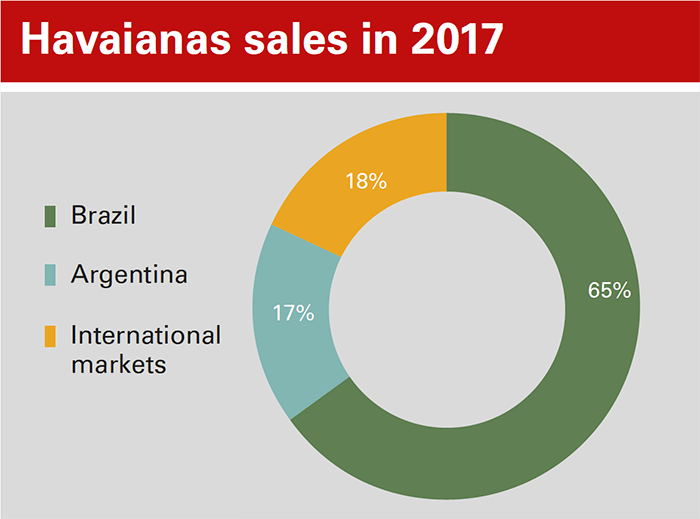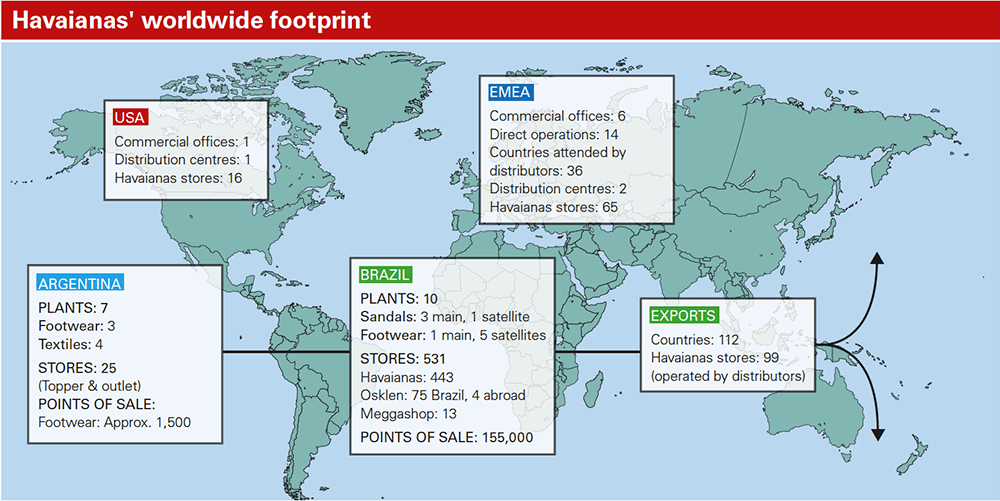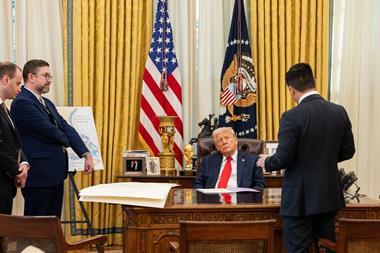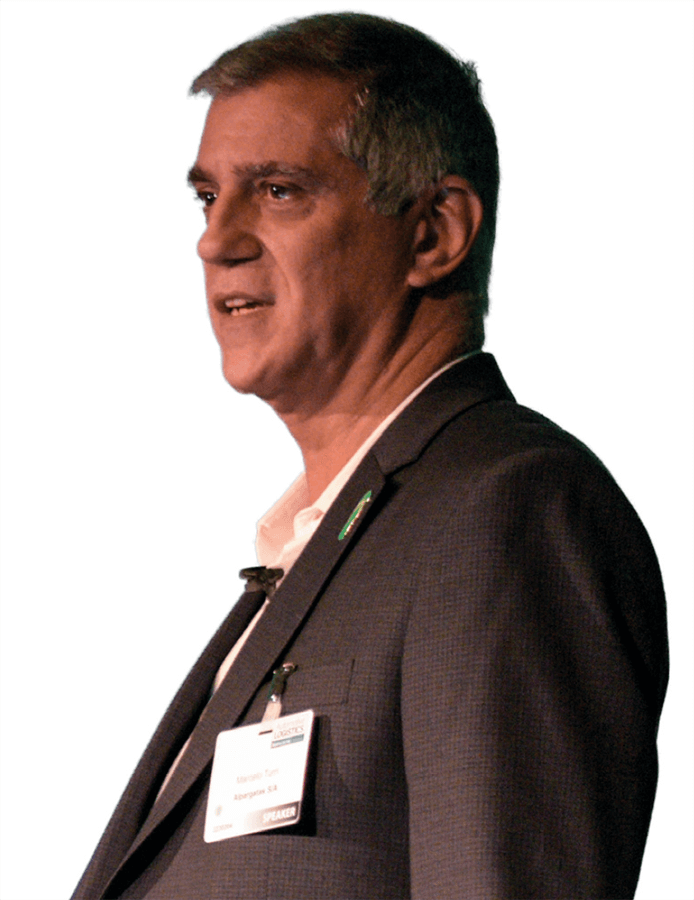 Could you give an overview of the logistical operation which supports Havaianas?We have different models in different regions, so in Brazil, we operate our warehouses but we have third parties that do the transportation for us. In the US, Europe and Asia, we have third parties that operate our warehouses as well as the freight transportation.
Could you give an overview of the logistical operation which supports Havaianas?We have different models in different regions, so in Brazil, we operate our warehouses but we have third parties that do the transportation for us. In the US, Europe and Asia, we have third parties that operate our warehouses as well as the freight transportation.
In Brazil, all of our ten plants are in the north-east and all of the warehouses are in the major plants. We have plants and satellites; satellites are very small plants for specific functions. Then we have just one distribution centre, a very simple one, that is near São Paulo because the demand is there for the products that we make ourselves.
We make the flip-flops but we buy accessories and apparel as finished goods, which we receive from our suppliers in Brazil or globally; we have suppliers in Latin America as well as Asia, even in Europe. We receive them in the port of Santos and then we distribute them from the centre in São Paulo. We sell the flip-flops directly from our plants, although we transfer a small part of the demand to São Paulo to supply our own stores; we have to be very quick to the market.
Which are your biggest markets?Brazil, of course, then after that Europe. There we have some very important countries: Italy, Portugal and the UK. But if we look five years from now, our bets are in Asia. We have a good presence there but not a strong one, so we are moving to Asia and also to the US, which is a very tough market for us. We are working a lot to conquer the US and South-East Asia.
Which ports do you use to distribute to the international markets?We distribute from two ports in Brazil. Suape in the north-east is the most important for our own operations, for international markets. For our distributors, the most important is Santos in the south-east, near São Paulo.
In Europe, we receive the products in Marseilles-Fos [France] and Antwerp [Belgium]. Then we have two distribution centres in Europe: one in Marseilles and the other in Liège, in Belgium.
In Argentina [where Havaianas has seven plants], Buenos Aires is the port and also the distribution centre.
We just launched a new operation in Colombia so we are there in Barranquilla and in Cartagena.
And in the US we receive the products in the port in New York then we send all the products to Columbus in Ohio; from there we ship across the country.
Do you find there is a lot of congestion in the ports in Brazil? For the automotive industry this tends to be an issue.Not congestion – our problem is space. When we export a lot from Brazil in serving these international markets, there is a shortage of containers and space in vessels. We are not these big automotive OEMs with a lot of volume. We are small and it’s very difficult to negotiate with the large shipping lines. They are making alliances, becoming stronger, and we are weak during the negotiations. Actually, we are starting to use cabotage. We don’t use railroads in Brazil but we are using more domestic shipping along the coast to send products from the north-east to the south-east of the country.
Initially the market for Havaianas was just Brazil and South America but the brand is now well-known internationally. How did the supply chain and logistics operation change to support the emergence of that global identity?There are many issues related to this global growth. First of all, when we are managing the supply chain in the short term, sometimes in Brazil there is a huge volume compared to the other regions. Sometimes it’s difficult for us to remember we cannot forget those markets because in the mid-term they are very important for us. So we are examining our processes in order to attend to the demand of all markets, no matter the pressure of the short term to maximise the results in this or in that market. In these countries we are being challenged by demands such as: how can we offer a better OTIF [on time in full], how can we speed up the supply chain?
There is another aspect. Outside Brazil, in Europe for example, our business is very seasonal. We start distributing during spring for our clients there, then comes summer, and then suddenly we don’t have business any more. It’s very difficult to put in an infrastructure; it’s expensive for us. What we are trying to do is negotiate variable space, variable capacity, variable everything – because we cannot afford to have an infrastructure at the peak of the business in these countries and then pay for idle capacity all year.
We will grow more, relatively, outside Brazil, so how do we put in place a supply chain that can serve this very complex situation? When we started our operations in Europe, we just had one distribution centre in Marseilles-Fos, but the transit time from the south of France to the south of Italy to the UK was becoming an issue, so this is why we opened a second warehouse in order to dramatically reduce the transit times; but then we had more idle space. It’s very difficult to solve this kind of trade-off: to invest in infrastructure as well as maintaining profitability.
It’s interesting that IT is part of your job title – it suggests IT is going to play an increasingly important part in solving these challenges. Is Havaianas implementing new systems?As supply chain people, we are hard users of IT; we don’t sell, we don’t produce, we just manage. So information is key for this function, first. Second, we used to be an industrial company, but our business model is changing a lot as we are becoming this brand with retail operations. Today we are a mix of industrial and retail; we have e-commerce, marketplace, direct channels, home stores, all of these things happening here in Brazil and in all of our markets. IT plays a strategic role in this environment.
We are pursuing a global IT architecture, which means the cloud, mobile [solutions], and a sales system as a global tool in all our regions. In our stores we are also pursuing a global retail system. We are trying to have an integrated order management system in order to accomplish service levels that are more challenging, and we are integrating the different ERPs that we have in all of our regions. So we are trying to face this digitalisation pressure and these new ways of selling.
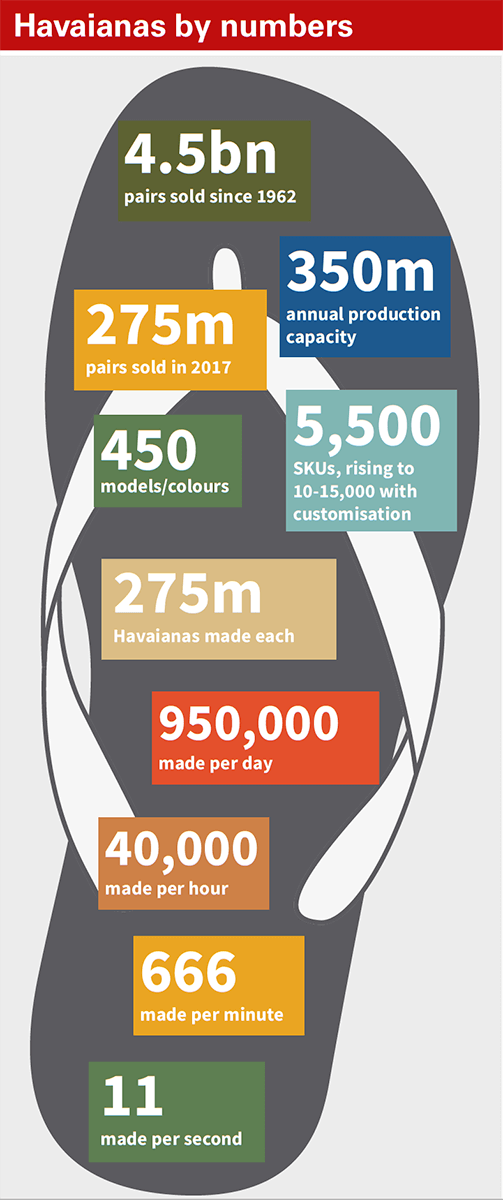 Can you discuss Havaianas’ recent machine learning project?As we grew from the 1980s to today, the number of SKUs [stock keeping units] increased a lot so forecast errors also grew, given the complexity of the demand. It is very difficult to forecast what we are going to sell. In order to maintain this complex trade-off – the loss of sales, capital invested in inventories, the utilisation of our plants – in a controlled way, we built two supply chains, one focused on cost, the other on flexibility. But it’s not enough, because after each collection or season we have a lot of raw materials that we have to write off, at a cost. So we launched a machine learning [ML] initiative.
Can you discuss Havaianas’ recent machine learning project?As we grew from the 1980s to today, the number of SKUs [stock keeping units] increased a lot so forecast errors also grew, given the complexity of the demand. It is very difficult to forecast what we are going to sell. In order to maintain this complex trade-off – the loss of sales, capital invested in inventories, the utilisation of our plants – in a controlled way, we built two supply chains, one focused on cost, the other on flexibility. But it’s not enough, because after each collection or season we have a lot of raw materials that we have to write off, at a cost. So we launched a machine learning [ML] initiative.
Can you explain a bit more about the two supply chains first?For base products in the Havaianas portfolio, cost is the most important variable in managing the supply chain. They are very predictable, non-perishable carry-overs. We don’t change the production planning given the fact that the demands change, because we have high utilisation of our assets. So this is a cost-driven supply chain. Then for the majority of our products, the forecast error is huge; these products are perishable, because after the season is over we launch a new collection. In this other supply chain, flexibility is the most important variable; we wait for the demand and we make a quick response.
But two supply chains is not enough any more, so we launched this machine learning initiative to help our commercial team. It’s not easy to know which style, which colour, we are going to sell more of so this [ML initiative] is allowing us to gain efficiency because we are reducing the forecast error. We are reducing the write-off of raw materials and we are reducing discounts [in outlets] at the end of the collection. We went to the limit with these supply chain tools, segmenting the supply chain by product behaviour, and now on top of that we are using machine learning.
When did the project start and is it active now?We did the pilot from the beginning to the middle of last year, so a six-month project. We took one part of the portfolio and we had to prove the concept. We also needed to learn which were the most important variables and algorithms to solve our problems. Now we have rolled out the ML after the pilot and this has become a monthly process. We still have a demand sensing process that is led from the commercial team, but with this tool now we give them analytical support for their forecasts. It is implemented and it’s helping us a lot.
What do you think Havaianas can learn from the automotive industry and what do you think the automotive industry can learn from Havaianas?I think there are many functions where there is a lot of room for us to learn, for example purchasing; we don’t have this kind of tight relationship with our suppliers [that the automotive industry does]. For us, there is a lot of collaboration to evolve in terms of supply chain management. I see the automotive industry as cutting edge in its supply chain techniques and tools, so I think we still have a lot to learn from this industry, for example in terms of logistics and warehousing.
From the opposite viewpoint, I believe it’s a trend in the automotive industry to customise more and this is the kind of thing we do a lot. We customise, we have colours, we have fashion, we have different sizes, different ways of selling, different channels. I believe that the automotive industry, in terms of selling channels, has evolved very little – the dealer model seems to be something that has stayed the same for a long time. The industry will be challenged to have e-commerce and mass customisation. How to predict and plan for that? That is something vehicle-makers can learn from the fashion industry.




























